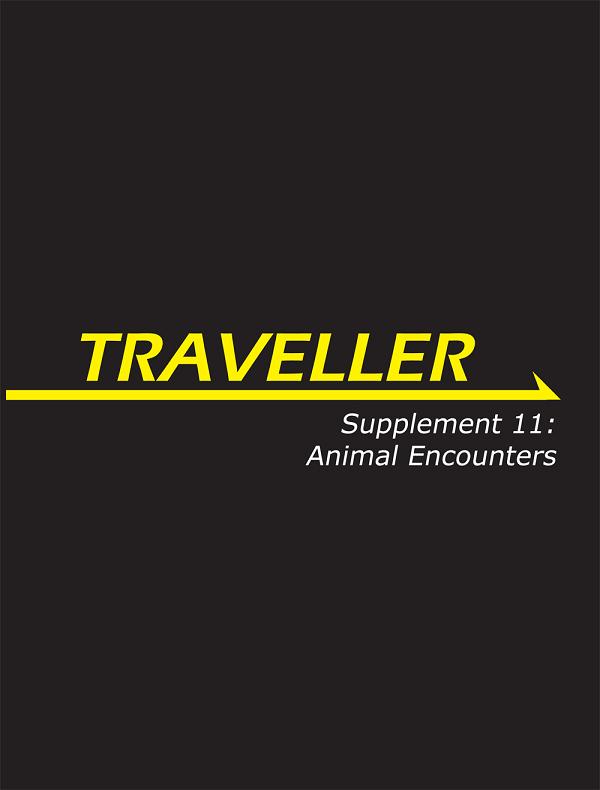Mongoose Traveller Supplement 11: Animal Encounters
 Supplement
11: Animal Encounters. August Hahn.
Supplement
11: Animal Encounters. August Hahn.
Mongoose Publishing http://www.mongoosepublishing.com
128pp., hardcover or PDF
US$24.99(H)$14.99(P)/UK£16.99(H)£9.71(P)
This article originally appeared on rpg-resource.org.uk in July 2015, and is reprinted here and in the November/December 2015 issue with permission.
This book takes a look at a long-neglected aspect of Traveller which is, after all, a space exploration game: the creatures that you may encounter on other worlds. If you take the premise that life has developed on multiple planets (which given the sheer number of ‘habitable’ ones is pretty obvious), that life is not going to be identical wherever you go. Indeed, having exotic (to our eyes) lifeforms is part of the ‘otherness’ of visiting different planets during the course of your game—and if so inclined you can weave them into your plotline, anything from specimen-collecting or hunting trips to being attacked by some savage beast you didn’t even know existed.
When not playing engineers or the ship’s chef, I quite often play a ‘xenobiologist’ whose very reason for being out in the black is to study the flora and fauna on the worlds he visits. If your game is one about exploration or colonisation, you are going to need to know about the creatures on the planets you investigate. Even if your game involves trade, or war, or going for a holiday, it may become important. Robert Heinlein, in his book Tunnel in the Sky gives a wonderful example when a survival instructor says “Beware of the stobor”. His students spend ages looking for a stobor before they realise that it’s not an actual creature but the concept of an unknown animal that might well be dangerous that they are being warned about!
The introduction begins with a discussion of what an ‘animal’ is and how animals behave… they are not cute, furry, people! Animals react to circumstances, they are not sentient, and respond to scary situations with a flight or fight response rather than a reasoned one. As general points of animal psychology are discussed, ways in which to make use of them within your game are suggested in a neat and useful manner.
Next comes “A Walk on the Wild Side”, a chapter which provides a comprehensive animal creation system. Based on a series of tables in typical Traveller fashion, it is designed to enable you to create believable alien animals with little effort, complete with all that you need to use them in play. Animals evolve to fill particular niches, so you need to decide early on in the process what sort of terrain your creature will be found in—this may, of course, be dictated by other aspects of the adventure you are planning. The creature will fall into one of several classifications (avian, reptile, insect, mammal, and so on), and will have appropriate modes of locomotion and behaviours to go along with it. Like many such systems, you can have hours of innocent fun just rolling up animals even if you have no specific use for them right now. Whilst this book is about animals, you do have the option of ‘fungals’—now most people lump fungi in with plants rather than animals, but there is certainly biological evidence to view them as a third kingdom, and here they might be able to move around. You can use the same section if you want a few self-mobile plants… why not, this is alien biology we’re talking about, after all!
Now, there are lots of interesting things you can do with the animals you create, but this being a role-playing game combat is never far away, so the next chapter is “When Animals Attack”. It provides numerous tables to allow you to set up animal encounters based on terrain type. Of course, these encounters do not need to involve conflict if that’s not what you want. Wherever you plot takes the game, there will be some options for random encounters—or you may choose to set them up in advance as part of your story. This section is also replete with little snippets of ideas and events that add more life to the proceedings—interactions, events and so on, all helping you to create the air of ‘otherness’ that reminds the players that their characters are not in their home town any more. This is, due to the multitude of options, the largest part of the book.
Finally, “The Galactic Menagerie” provides an array of ready-designed critters for you to let loose, or at least to serve as examples for your own designs. There are also some charts to allow you to modify creatures depending on the environment in which they are to be found—so you can have a tropic rain forest or open plains version of a given animal, similar enough that the relationship can be discerned but different enough to be distinct… and of course, fitting in with wherever it is that they live.
Overall, this provides a good and comprehensive if mechanistic way to come up with animals to be found on all those worlds that are out there for your Travellers to explore. A few examples of how to take a creature from fiction and slot it in to the system, so that you can generate the essential statistics to use it in your game, would have been a useful addition... and I do wonder what they all taste like and how you cook them!
 Freelance
Traveller
Freelance
Traveller